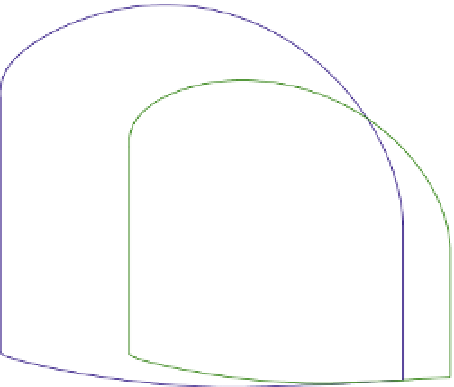Biomedical Engineering Reference
In-Depth Information
150
+25%
control
100
-25% inotropy
50
0
40
60
80
100
120
Ventricular Volume V
LV
[ml]
FIGURE 4.53
Left ventricular pressure-volume work loops computed for the complete human circulation
model (Figure 4.50) for control and varied inotropy, achieved by changing the contractile parameter
c
in
Eq. (4.75) for each heart chamber
25 percent.
since the more forcefully ejecting heart leaves less volume available for the subsequent heart-
beat. Inotropy is regulated by the autonomic nerves, augmented by sympathetic adrenergic
effects of circulating catecholamines, such as epinephrine, the so-called “fight or flight”
response to stress. Inotropic drugs used clinically to stimulate the heart in acute and chronic
heart failure include digoxin and the beta-adrenoceptor agonists dopamine, dobutamine, epi-
nephrine, and isoproterenol.
The complete circulatory system model may be used to study interactions between left
(systemic) and right (pulmonary) circulations. Figure 4.54 shows left and right ventricle
work loops for the normal heart ejecting into the normal (control) circulatory system,
depicted by solid curves. The right ventricle work loop is smaller, as expected, than the left.
Figure 4.54 also shows the same two work loops for a weakened left ventricle (dashed
curves). As expected, this left ventricle work loop is diminished in size and shifts to the
right on the volume axis. Since the weaker ventricle ejects less blood, more remains to fill
the heart more for the subsequent beat (EDV of 192 instead of 119 ml). This increased filling
partially compensates for the weakened ventricle via Starling's law (increased pressure for
increased filling).
Table 4.5 shows examples of congestive heart failure, resulting from decreases in
for
the left ventricle and for the right ventricle. Decreasing left ventricular contractile state to
one-third of the control value lowers the left ventricular ejection fraction from 55 to 27 percent,
and root aortic pulse pressure decreases from 131/58 to 102/47 mmHg. Left ventricular stroke
volume decreases less, from 66 to 53 ml, since it is compensated for by the increased left end-
diastolic volume (192 ml) via Starling's law. Decreasing left ventricular contractile state is
equivalent to left congestive heart failure. Consequently, pulmonary venous volume increases
from 1,540 ml to 2,057 ml (not shown), indicating pulmonary congestion for this case.
c






















